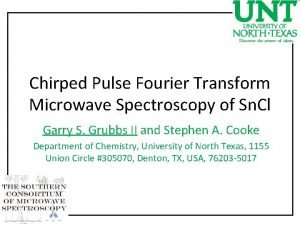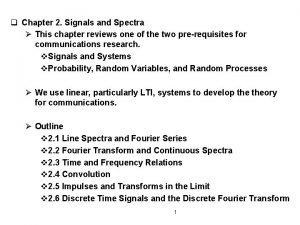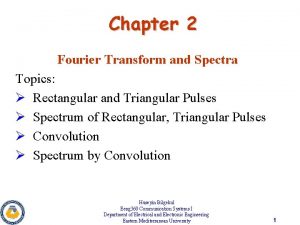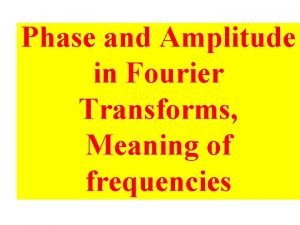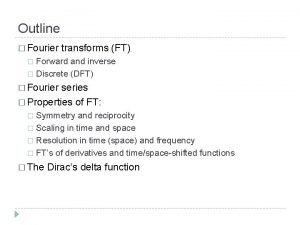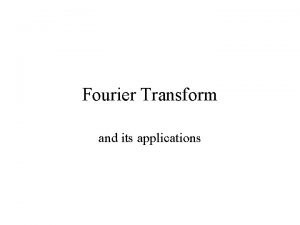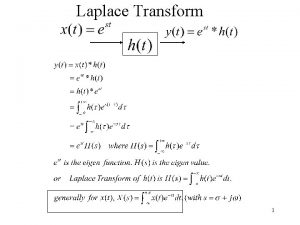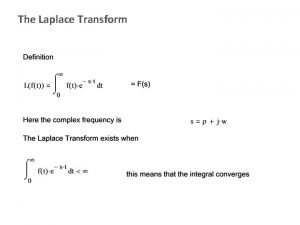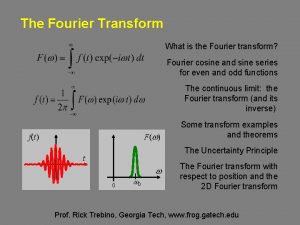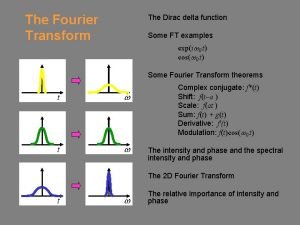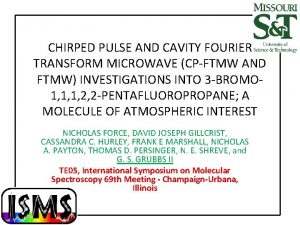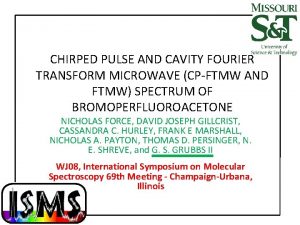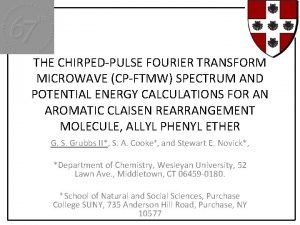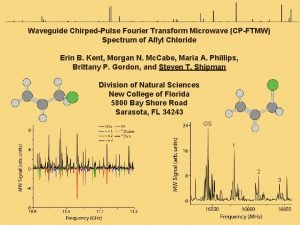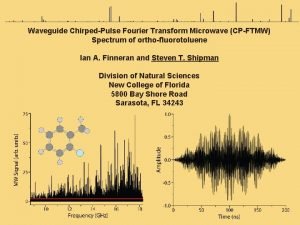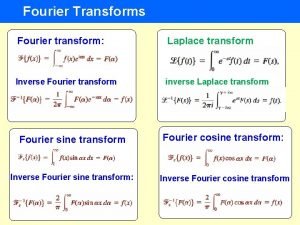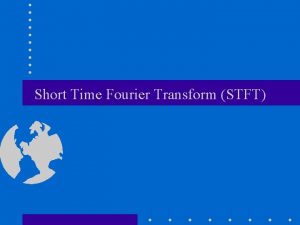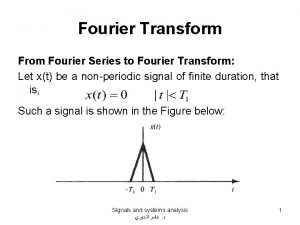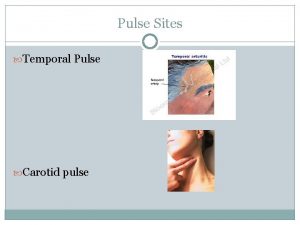CHIRPED PULSE AND CAVITY FOURIER TRANSFORM MICROWAVE CPFTMW














- Slides: 14

CHIRPED PULSE AND CAVITY FOURIER TRANSFORM MICROWAVE (CP-FTMW AND FTMW) SPECTRUM OF BROMOPERFLUOROACETONE NICHOLAS FORCE, DAVID JOSEPH GILLCRIST, CASSANDRA C. HURLEY, FRANK E MARSHALL, NICHOLAS A. PAYTON, THOMAS D. PERSINGER, N. E. SHREVE, and G. S. GRUBBS II WJ 08, International Symposium on Molecular Spectroscopy 69 th Meeting - Champaign-Urbana, Illinois

Outline • Driving Force • Background • Theory • Experimental Methods • Setting Up Laboratory • Data and Results • Future Work

Driving Force • To put the bromoperfluoroacetone species into context with other perfluoroacetone/perfluorohexanone derivatives 1, 2 • To further our understanding of the “wet-dog” tunneling motion or Bistrifluoromethyl effect led by S. A. Cooke and coworkers. 3, 4 1. J. -U. Grabow, N. Heineking, and W. Stahl. Z. Naturforsch. 46 a (1991) 229. 2. G. Kadiwar, C. T. Dewberry, G. S. Grubbs II and S. A. Cooke. RH 11, 65 th ISMS (2010). 3. G. S. Grubbs II, Stewart E. Novick, W. C. Pringle, Jr. , Jaan Laane, Esther J. Ocola, and S. A. Cooke. Journal of Physical Chemistry A. 116 (2012) 8169. 4. W. C. Bailey, R. K. Bohn, G. S. Grubbs II, Z. Kisiel, S. A. Cooke. MH 05, 68 th ISMS (2013).

Background - Perfluoroacetone A = 2181. 71980(14) MHz B = 1037. 22930(7) MHz C = 934. 89233(8) MHz

Background - Perfluoroacetone

Background - Chloroperfluoroacetone Parameter 35 -Cl 37 -Cl A 1770. 54709(61) 1753. 6359(18) B 852. 96221(45) 841. 6904(12) C 816. 40819(59) 804. 8988(11) DJ 0. 0774(24) 0. 0787(58) DJK -0. 075(11) -0. 086(33) DK 0. 181(14) 0. 247(94) d. J 0. 0143(15) 0. 0184(29) d. K 0. 75(16) 0. 73(39) caa 13. 206(24) 9. 413(37) cbb -15. 011(32) -14. 430(49) ccc 1. 805(21) 5. 017(32) cab -32. 6(70) -34. 0(97) cac -31. 8(72) -16(21) cbc -43. 89(57) -33. 0(11) N 326 (J = 3 to 12) 170 (J = 3 to 10) rms 0. 0051 0. 0060

Theory Parameter Value A /MHz 1449. 2 B /MHz 632. 9 C /MHz 591. 0 a dipole 1. 39 D b dipole -1. 14 D c dipole -0. 34 D Calculations made at the MP 2/6 -311++G level on the Gaussian 03®, Revision C. 1 suite

Experimental Methods • FTMW spectrometer from Oxford University to date, CP-FTMW planned • Purchased directly from Syn. Quest Labs® and used without further purification • Bubbled Ar at ≈2 atm through sample in a “U”shaped tube in ice ≈40 cm upstream from nozzle

Setting Up Laboratory • FTMW purchased from Oxford University was first to arrive • We have now successfully reconstructed this FTMW spectrometer with all software

Setting Up Laboratory Mark Stephen Snow, Spectroscopic Investigations of Chiral and Induced Chiral Interactions. 2006 Ph. D Thesis for Oxford University.

Results and Data • Used theoretical constants in SPCAT 1 and AABS 2 to predict and sort where to start search on FTMW while CP-FTMW was being constructed • Search started in the 10999 -11021 MHz region where there are predicted many J = 9 – 8, a-type transitions 1. H. M. Pickett, J. Mol. Spectrosc. 148, 371 (1991). 2. Z. Kisiel, L. Pszczolkowski, I. R. Medvedev, M. Winnewisser, F. C. De Lucia, E. Herbst, J. Mol. Spectrosc. 233, 231 -243(2005)

Results and Data • Doppler split transitions found and gasdependent! (all spectra ≤ 500 nozzle pulses)

Future Work • CP-FTMW Run for Less Sample Consumption • Collect More Spectra • Fit and Assign Remaining Spectra • Continue to Setup Laboratory

Acknowledgements • Startup funds from MS&T • University of Missouri System Research Board Grant • Pete Pringle, Stew Novick, Steve Cooke, Brian Howard, and Jens-Uwe Grabow
 Chirped pulse fourier transform microwave spectroscopy
Chirped pulse fourier transform microwave spectroscopy Thoracic cavity
Thoracic cavity Pulse train fourier transform
Pulse train fourier transform Fourier transform of shifted rectangular pulse
Fourier transform of shifted rectangular pulse Chapter 7 2 body planes directions and cavities
Chapter 7 2 body planes directions and cavities The abdominal cavity is to the thoracic cavity
The abdominal cavity is to the thoracic cavity Greater and lesser sac
Greater and lesser sac Visceral and parietal peritoneum
Visceral and parietal peritoneum Phase invariance
Phase invariance Forward fourier transform
Forward fourier transform The fourier transform and its applications
The fourier transform and its applications Relationship between laplace and fourier transform
Relationship between laplace and fourier transform Laplace transformation table
Laplace transformation table Inverse fourier transform
Inverse fourier transform Fourier transform of dirac delta function proof
Fourier transform of dirac delta function proof
